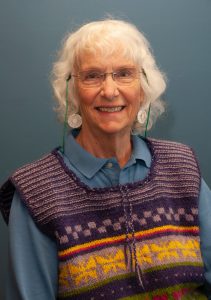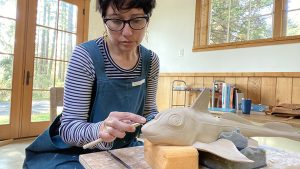 In this “different flavor” Tide Bite, Fernanda Oyarzun describes the increasing recognition of the value of crossing the sometimes-hard boundaries between science and art. Such cross-disciplinary work can lead to new creative insights, as she demonstrated at FHL while here last Fall as an Artist-in-Residence. This wonderful program which exists thanks to the vision and support of the MacFarlane family, is designed to not only create a haven for artists to work in a lovely space, but also to “give back” to the FHL community of students and resident scientists. Fernanda did this in a variety of ways, as she discusses. We love the “special sauce” this adds to campus life!
In this “different flavor” Tide Bite, Fernanda Oyarzun describes the increasing recognition of the value of crossing the sometimes-hard boundaries between science and art. Such cross-disciplinary work can lead to new creative insights, as she demonstrated at FHL while here last Fall as an Artist-in-Residence. This wonderful program which exists thanks to the vision and support of the MacFarlane family, is designed to not only create a haven for artists to work in a lovely space, but also to “give back” to the FHL community of students and resident scientists. Fernanda did this in a variety of ways, as she discusses. We love the “special sauce” this adds to campus life!
Experiencing the Landscape of Knowledge on a Human Scale: Artist-in-Residence at FHL
by Fernanda X. Oyarzun
Fernanda has a PhD in Biology from the University of Washington and Bachelor of Biology from Pontificia Universidad Católica de Chile. She is a Fulbright Scholar with training in Interdisciplinary Pedagogy, Scientific Illustration, and Editorial Design. She works as an interdisciplinary researcher and as a process-based, place-based visual artist, navigating both worlds – science and art – exploring embodied knowledge and the ecology, diversity, and evolution of marine life. She is a co-founder of several interdisciplinary co-creative projects including “Bienal Concepción, Arte y Ciencia”, and “Robsonella Project”, a contemporary scientific illustration educational project. As a visual artist, she has participated in exhibitions both in Chile and abroad, including the Biennial Personal Structures in Venice, Italy in 2022. She has completed artscience residencies at the “Artist-at-sea” program of the Schmidt Ocean Institute, Friday Harbor Laboratories (USA), and at L’Aquila Reale (Italy). She is currently an associate researcher at Coastal Social-Ecological Millennium Institute (SECOS), where she directs art & science research.
When I arrived at Friday Harbor Labs twenty-one years ago, the fusion of art and science practices hadn’t yet gained the favor it enjoys today in academia, nor was it seen as a viable career path. Although in previous centuries knowledge had been seen as a more integrated landscape, we spent the 20th century dividing it into mostly well-contained disciplines. Nevertheless, perhaps unknowingly, it was exactly the intersection of art and science that drew me to FHL. With the promise of spending five weeks observing embryos under the microscope and drawing, I embarked on a life-changing experience through the Comparative Invertebrate Embryology course, which eventually led me to change my thesis and make FHL a place where I would often find excuses to return. That first summer at the Labs wasn’t just a journey of exploration of the inexhaustible wonder of larval development and its evolution, diversity, beauty, and complexity, but also a journey into thinking about science as an experiential embodied collective practice. Here, knowledge was not merely absorbed but lived, approached with a blend of deep curiosity and playful experimentation — an experience to be encountered through direct contact with organisms and ecosystems, a human-scale engagement with knowledge.

As an interdisciplinary researcher and visual artist, my return to FHL in Fall 2023 (thanks to efforts of Adam Summers and a Macfarlane Art Studio Fellowship) was as significant as my first visit. Friday Harbor Labs has welcomed artists for some time, as evidenced by the 24-year-old Whiteley Center. Immersing myself in the role of artist-in-residence granted me an expanded sense of freedom to navigate the labs, rekindle connections with former labmates and mentors, and witness the evolution of their scientific perspectives and unwavering passion for knowledge. Witnessing the Labs’ ability to progress and adapt to changing times while retaining their essence as fertile playground for groundbreaking research was profoundly inspiring. Throughout my residency, alongside my artistic research, I actively engaged with the FHL community. I delivered three lectures on the intersection of art and science, beginning with a presentation at the wonderful GEODUC Scholars Initiative and culminating in the opening address at the interdisciplinary FHL Science-Poetry Symposium. Furthermore, I gave a lecture at a course taught by Eric Edsinger, also joining in the field and throughout the quarter, learning from students’ ongoing research projects and witnessing the scientific eye, curiosity and independent critical thinking being formed in these young scientists. Additionally, I guided an introduction to drawing in the undergraduate Autumn Marine Studies course taught by Dr. Summers (Figure 2). Participating in the FHL Mentor/Mentee Program, I exchanged insights on interdisciplinary research with a wonderfully inquisitive student, Maya Kurkhill.

But of course, the heart of my residency lay in the pursuit of artistic research, which provided me with ample material to work on through the coming year. The term ‘artistic research’ might be as difficult to define as the term ‘species’ is for a biologist; it depends on the context and definition. Nowadays, many artist residencies are divided into two types: residencies focused solely on creation, where the aim is to produce a body of work by the end, and others dedicated to artistic research, where the act of creation intersects with analysis and thought, employing various methodologies. The process itself is enriching and open-ended. In my case, the FHL residency will integrate with the artistic research I conducted during a subsequent residency in Italy. Through these investigations, I aim to develop a body of work that will hopefully culminate, among other things, in an exhibition.

So during the first week at FHL, while exploring the ongoing research, a ratfish tank in lab 8 caught my attention with the tender gaze of these “chimeras,” far more captivating than any internet image could convey. Delving deeper into Karly Cohen’s research in Adam’s lab on the evolution and development of ratfish teeth, and connecting it with studies on related species in Chile, I found myself down a rabbit hole of interconnected research and stories spanning space and time. Sketching them live, consulting books and theses older than a hundred years, and visualizing recent CT-scans of their morphology, I crystallized my understanding of the research on Hydrolagus colliei through my fingers, creating a first sketch study-sculpture that I brought back with me to Chile to continue that thread of this research (Figures 1 and 3). Engaging with Eric Edsinger’s class and witnessing the students’ enthusiasm during moments of discovery, I revisited species that I had previously drawn or encountered in the labs and in the field, such as the unusual sea slug Melibe leonina. Thanks to the freedom that artistic practices grants us, I began a second three-dimensional sketch, a clay sculpture, consulting references like Louise Page’s thesis, sketching the animals at the water table and under the microscope, and connecting them with research in neurobiology by Dennis Willows, as well as ecological research on the eelgrass beds they inhabit by Drew Harvell (Figure 4). This research also resonated with ongoing research in Chile on Zostera chilensis, weaving a rich tapestry of global scientific endeavors in exploration and connection. Lastly, interacting and learning through the journal club and many wonderful conversations with my PhD Advisor, Richard Strathmann, Megumi Strathmann, my thesis committee member Billie Swalla, Victoria Foe and many more, expanded the scope of the artistic research I conducted that quarter. It led me to contemplate various topics ranging from development and deuterostome phylogeny to the role of time in gene expression through introns.

Although I could write at least ten more pages about the wonderful experiences I had last Fall at the Labs, I want to conclude with just a few thoughts. I am increasingly convinced that a space intended for investigating the world should be situated within that world (i.e. not in a distant cubicle disconnected from nature), and ideally equipped with tools that allow us to engage with exploration at various scales; sometimes it may be a microscope, other times an oceanographic vessel, and yet at other times, it might be an easel, a poetry symposium, or clay (Figure 5). I believe that nurturing young scientists, artists, and interdisciplinary researchers can only benefit from the detailed observation and deep understanding fostered by our hands and bodies during immersive experiences of discovery. Knowledge, to me, seems to be a landscape that needs to be inhabited with our full minds and bodies, and often in community. During the Fall of 2023, I had the fortune to explore the ongoing research of others on site, in real time, through sculpture, videos, interviews, and sketches, and this year I am developing a body of work that hopefully will transmit part of the wonderful spirit, implications, or reflections of that research. I was heartened to see that FHL has somehow remained partially protected from the productivity anguish of academia while simultaneously producing high-impact research and papers. This brings a beautiful paradox and hope to the stressful environment that many academic institutions experience and draws our attention to alternative paths where creativity and playful exploration are nurtured in direct contact with nature and in a human-scale experience of science.

Artists, with their keen observational skills and profound interest in the spaces between knowledge, could play an essential role in fostering and strengthening this characteristic, both at Friday Harbor Labs and in science in general. I applaud the artist-in-residency initiative and hope that many more field stations will join in supporting these efforts.
Website: www.fernandaoyarzun.com
Instagram: @Fernie1977
Tide Bites is a monthly email with the latest news and stories about Friday Harbor Labs. Want more? Subscribe to Tide Bites or browse the archives.